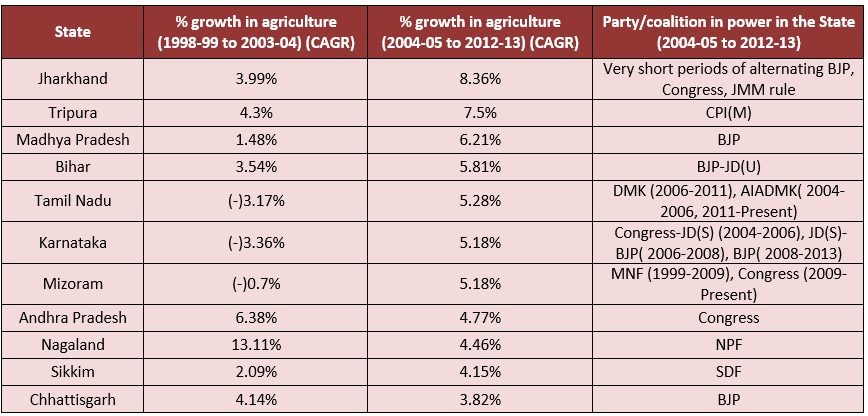The Surprising Story Behind India's Fastest Growing Agri States
What does politics have to do with agriculture ? Lots it might appear, but maybe not for the reasons that usually come to mind.
A quick backdrop first. India's Economic Survey, 2013-14 says that a “1% growth in agriculture is at least two to three times more effective in reducing poverty than the same growth emanating from non-agricultural sectors”. Unsurprisingly, the manifestos of all political parties recognize the importance of agriculture and the need to strengthen it. While the BJP talked about “productive, scientific and rewarding” agriculture, the Congress manifesto committed to providing an “impetus to agricultural growth, productivity and incomes”.
But how did this sector perform during the terms of the NDA and UPA at the Centre? Which States recorded the fastest growth in the past 10-15 years? More critically, how much of a role can the Centre play in a sector like agriculture, which is a State subject under our Constitution? Swaniti Initiative attempts to answer these questions by looking at agricultural growth across States and years.
In the 9 years (2004 to 2013) of Congress-led UPA rule at the Centre, the average year-on-year growth rate in Indian agriculture was 3.6%. This was significantly higher than the 2.43% achieved during the 6 years (1998-2004) of NDA at the Centre. However, during the UPA term, it is pertinent to note that some of the fastest growing States in terms of agricultural production were not ruled by the Congress.
In these 9 years, Madhya Pradesh recorded a year-on-year growth rate of 6.21%, the 3rd highest in the country. It was the fastest growing agricultural State in 2012-13 with a phenomenal growth rate of nearly 19%. Bihar, another State ruled almost entirely by the BJP-JD(U) during the UPA term at the Centre, recorded the 4th highest agricultural growth of 5.81% in this period.
Among the 11 States with agricultural production grew faster than the national average of 3.59, only Andhra Pradesh was ruled by the Congress for a substantial length of time. However, Andhra Pradesh grew much faster during NDA’s rule at the Centre (6.38%) than during the UPA’s rule (4.77%). The table below illustrates this:

Source: Planning Commission
Tripura has been a silent yet stellar performer in agriculture. It has recorded the second highest year-on-year growth rate over the past decade at 7.5% per annum. This has been made possible by a focus on farm mechanization and the use of innovative techniques like the System of Rice Intensifications (SRI) to improve yields. Sikkim’s success at organic farming has demonstrated that sustainable farming also offers significant financial benefits to farmers.
The decision to amend the APMC Act to open up agricultural markets paid rich dividends in Bihar in 2006. Madhya Pradesh and Andhra Pradesh were one of the first States to introduce participatory irrigation management (PIM) through legislation, under which Water User Associations (WUAs) of local farmers are mandated to manage irrigation resources. This leads to higher water use efficiency and greater agricultural productivity.
It is evident from the above that if the farm sector is to be strengthened, States will need to play a leading role. They can do so by either bringing in reforms in the sector, or by better utilization of funds and assistance under Centrally Sponsored Schemes, or a combination of both. The Central government has increased its allocation to the Ministry of Agriculture from Rs 5,283 crore in 2004-05 to Rs 13,558 crore in 2014-15.
Also, as IndiaSpend had observed in a detailed analysis of the Budget 2014-15 documents, the government of India is more committed towards decentralizing the development process. Ministry of Agriculture is one of the ministries to get a high proportion of the funds now allocated towards the state plans. This may prove to be seminal in promoting more growth, as observed in the analysis above. State governments would still be more responsible for better outcomes in this sector. A holistic focus on irrigation, use of technology and better marketing of agricultural produce hold the key.
The authors would like to acknowledge https://jigyasa.swaniti.in/ as the source for information on various agricultural metrics



